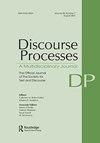The Development of Referring Expression Use from Age 4 to 7 in Swedish-Speaking Children
IF 2.1
2区 心理学
Q2 PSYCHOLOGY, EDUCATIONAL
引用次数: 0
Abstract
ABSTRACT When telling a story, a speaker needs to refer to story characters using appropriate expressions, which requires a mental model of the discourse. We hypothesize that, compared to those of adults, children’s discourse models are based more on factors that are less cognitively demanding, such as animacy, and as they grow older, discourse factors such as givenness will start to play a larger role. To test this, we conducted a longitudinal study of referring expression use in elicited narratives. Swedish-speaking children (n = 17) were tested three times between age 4 and 7 and compared to adults (n = 20). The results show that children, like adults, take into account if, when and how a character has been mentioned earlier when referring, but that they rely more on animacy than adults. These results indicate that the various cues for referential choices are in place in preschool children’s discourse models, but are weighted differently than in adults.4 ~ 7岁瑞典语儿童指称表达使用的发展
在讲故事的过程中,说话者需要使用恰当的表达方式来指称故事人物,这就需要一个话语的心智模型。我们假设,与成人相比,儿童的话语模式更多地基于对认知要求较低的因素,如animacy,随着年龄的增长,给予性等话语因素将开始发挥更大的作用。为了验证这一点,我们对引申叙事中指称表达的使用进行了纵向研究。讲瑞典语的儿童(n = 17)在4岁到7岁之间接受了三次测试,并与成人(n = 20)进行了比较。结果显示,孩子们和成年人一样,在提到一个角色时也会考虑是否、何时以及如何被提及,但他们比成年人更依赖于动画。这些结果表明,学龄前儿童话语模型中存在各种参考选择线索,但其权重不同于成人。
本文章由计算机程序翻译,如有差异,请以英文原文为准。
求助全文
约1分钟内获得全文
求助全文
来源期刊

Discourse Processes
Multiple-
CiteScore
4.30
自引率
4.50%
发文量
27
期刊介绍:
Discourse Processes is a multidisciplinary journal providing a forum for cross-fertilization of ideas from diverse disciplines sharing a common interest in discourse--prose comprehension and recall, dialogue analysis, text grammar construction, computer simulation of natural language, cross-cultural comparisons of communicative competence, or related topics. The problems posed by multisentence contexts and the methods required to investigate them, although not always unique to discourse, are sufficiently distinct so as to require an organized mode of scientific interaction made possible through the journal.
 求助内容:
求助内容: 应助结果提醒方式:
应助结果提醒方式:


